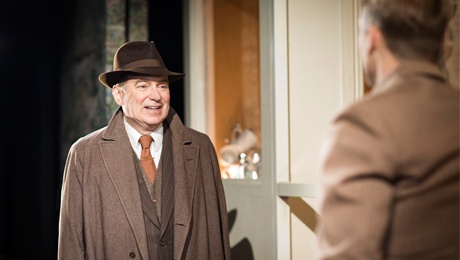It’s like the setup of a bad joke: two men meet on a train. They discuss their woes (one wants to kill his father, the other comments he wouldn’t mind if his unfaithful wife disappeared). They joke about “swapping murders” in a pact to ensure they won’t be caught. Then one of them carries it out. And won’t go away until he gets what he wants… laughing yet?
Made famous by the Hitchcock movie adaptation, this version by Craig Warner goes backs to basics and remains true to the original Patricia Highsmith novel. However, it never really satisfies, as our protagonist Jack Ashton is a bit one note as Guy, while Chris Harper as antagonist Bruno is sometimes off-key (especially when giggling and/or singing some lines of dialogue to a non-existent melody). There is a rather large cast but none of the other characters are fleshed out in any memorable way; they are either ciphers or so underdeveloped they are background. It’s a rather mixed bag on a few fronts: the first act is exposition heavy, the second more dramatic but with a conclusion that is rather too trite.
Throughout, the age of the source material shows. This is a story which relies on mommy’s boy Bruno developing an overwhelming sexual attraction to a Guy (“You liked me. I didn’t imagine that” he implores at the conclusion) and stalking him to a psychotic extent, tainting every aspect of Guy’s life from his new home to his wedding photos. Bruno reads like Guy’s dirty little secret: the moment where he telephones (complete with amplified “phone line” voices) feels like a deleted scene from Victim. Such dangerous transgression wouldn’t really be plausible in a modern setting, and wisely this production is set in a Mad Men-esque America of the past.
The functional set from David Woodhead is both a blessing and a curse. Aided by impressive projections, various panels slide to reveal all manner of locales, ingeniously working over two levels at times. This has the curious effect of placing the action inside a big doll’s house on stage. You could argue this makes proceedings more claustrophobic. But sometimes the spaces are so small the actors come across as rather stilted and unable to move. Worse, it creates yet more distance between them and the audience. The internal lighting in these boxed rooms also hurts the eyes at various points. When the actors step in front of the sets and out of the box, things become more naturalistic and engaging. The box is blissfully pulled apart for the final moments as the crushing burden on Guy is finally removed. However, this is awkwardly marred by some props abandoned centre right from the previous scene.
A serviceable ride that never dazzles or fully engages, the production could do with more action and tension. Indeed, for a drama about murder it is violence-free. All the elements are there for a truly great show, they just don’t cohere.


Comments